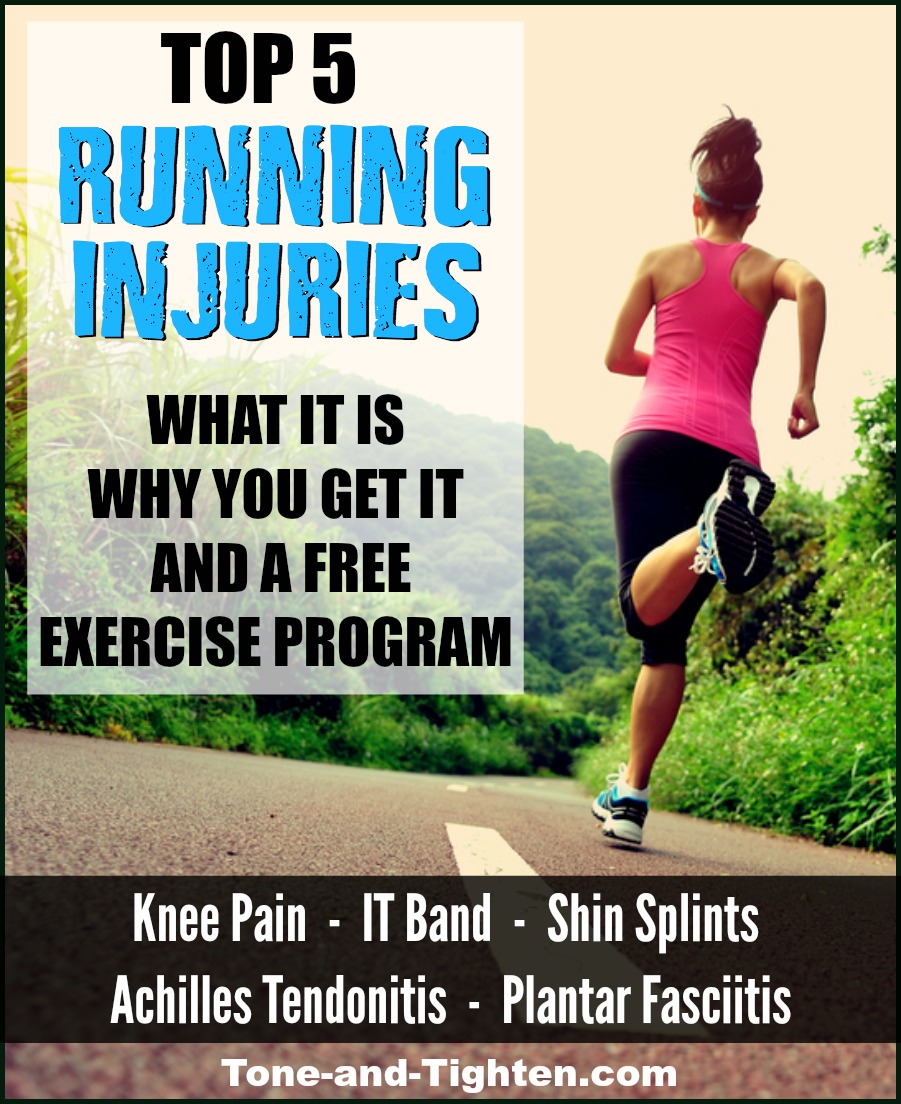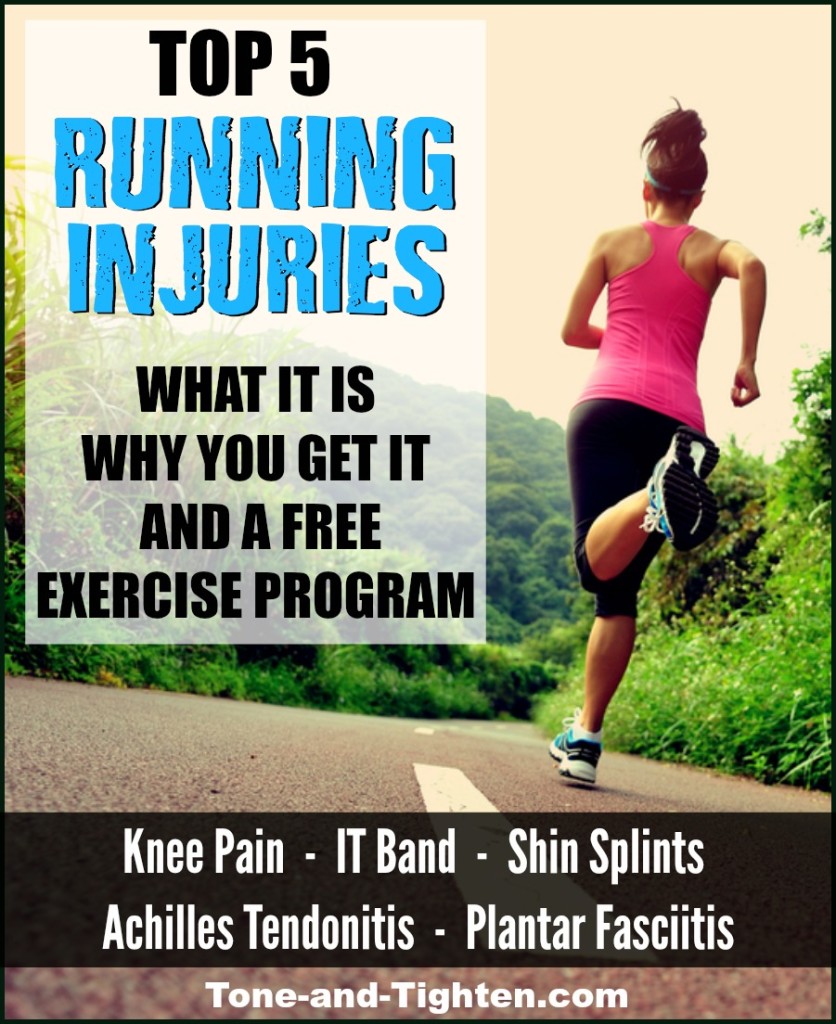Workouts, recipes, motivation, tips, and advice all right to your inbox! Subscribe to Tone-and-Tighten.com using the black bar up at the top of the page.
Spring is finally here! The sun is shining, the birds are chirping, and the sound of running shoes can be heard on roads, sidewalks, and trails everywhere! As a runner, I love getting out and seeing where my feet can carry me. As a doctor of physical therapy, I love treating runners and running – related injuries. This year, however, I thought I would take a more proactive stance and share with you some ways that you can stay out of my clinic this year! Today will be discussing the top five running – related injuries: what they are, what you get them, and some simple stretches/exercises you can do to ensure strong, injury free running this year!
Please note – in the information I present below I briefly present but a small summary of each condition. If you want to learn more I encourage you to visit the accompanying links to the entire post for your specific injury. You can do this by clicking the title, the picture, or the last sentence in each section about each injury. Thank you, and enjoy!
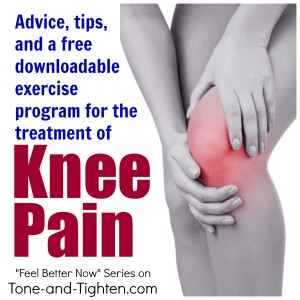 What is it? Patellofemoral pain is refers to pain that occurs in and around the patella (kneecap). This anterior knee pain most often occurs laterally (on the outside of the kneecap) and is often exacerbated with activity. Running and stairs are two of the primary culprits that increase pain in this area while rest and ice typically offer the most pain relief. It’s usually a gradual thing that comes on slowly over time as opposed to an accident or injury.
What is it? Patellofemoral pain is refers to pain that occurs in and around the patella (kneecap). This anterior knee pain most often occurs laterally (on the outside of the kneecap) and is often exacerbated with activity. Running and stairs are two of the primary culprits that increase pain in this area while rest and ice typically offer the most pain relief. It’s usually a gradual thing that comes on slowly over time as opposed to an accident or injury.
Why do you get it? Patellofemoral pain is typically caused by the kneecap not moving correctly over the knee joint. This mechanical issue is typically caused by one or both of the following reasons: 1) an imbalance of forces pulling on the kneecap (tight outer thigh and weak inner thigh) and 2) hip weakness leading to malalignment. Both of these conditions cause the kneecap to travel poorly while running which results in knee pain.
What do we do about it? In its very simplest form, the treatment for this knee pain is to stretch where is tight and strengthen where is weak. Any sort of stretching you can do to the lateral (outside) part of the thigh is a good thing. Combine that with strengthening to the hips and quads to improve kneecap alignment and you’re in business! Click here for more information on this condition including a FREE downloadable home exercise program to help you feel better.
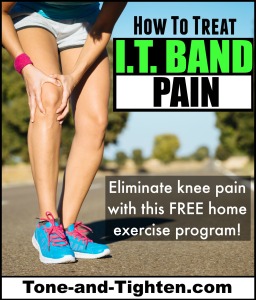 What is it? The iliotibial band is actually a long broad tendon on the outside of your thigh. There is a little small muscle that comes off the front of your hip called the tensor fascia latte. The tendon to this muscle is incredibly long – it essentially runs the length of the entire outside of your thigh. It then crosses the knee joint and connects to your tibia just below your kneecap on the outside part of your tibia.
What is it? The iliotibial band is actually a long broad tendon on the outside of your thigh. There is a little small muscle that comes off the front of your hip called the tensor fascia latte. The tendon to this muscle is incredibly long – it essentially runs the length of the entire outside of your thigh. It then crosses the knee joint and connects to your tibia just below your kneecap on the outside part of your tibia.
Why do you get it? IT band pain is typically caused by three things (most of the time 2 or three are present): excessive tightness in the IT band, hip weakness, and overuse. When there is too much tension in the IT band it rubs back-and-forth over the bony prominences on the outside of your knee. Over time, this excessive friction can cause pain in the tendon. Hip weakness results in faulty knee alignment and mechanics during movement; this is another common cause. I also treat IT band pain a lot for people who are increasing their activity. It’s probably one of the most typical overuse injuries that I see. Simply put – people try to increase too much too quickly. This sudden increase in stress on your joints/muscles results in increased strain in the area of your IT band and that sucker really starts to hurt!
What do we do about it?
Acute (less than two weeks): The principles of RICE apply – rest, ice, compression, and elevation. (To read more about acute injury management click here). Resting (taking a break from activities that cause pain), icing (20 minutes on 20 minutes off 3–4 times daily), compression (there are different types of neoprene sleeves and straps that can reduce IT band friction at your knee joint), and elevation (keep your knee propped up while resting and icing; more important if there is swelling present), are your first line of defense in the management of pain from acute injuries.
Chronic (longer than two week): A typical inflammatory response lasts approximately two weeks – after that we need to be a little bit more aggressive to actually stimulate a healing response in the tendon. Deep massage (from another person or using a foam roller) is usually my first line of defense. Follow that up immediately with some IT band stretches and hip strengthening exercises found below. The important difference in treating more chronic pain is that you’re going to want to aggressively try to loosen up your entire IT band and outside of your leg and then combine that with aggressive stretching to your lateral hips, butt, and hamstring muscle groups. Throw in a few strengthening activities and you’re well on your way to healthy knees!
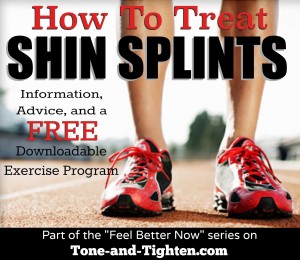 What is it? Shin splints manifest as pain that occurs in and around your shin bone. You will get this pain in one of two places – most commonly down the inside part of your shin and less commonly on the front/outside of your lower leg just under your knee. For the purposes of this article we’ll talk about the more common type of shin splint which is down the inner part of your leg (medial tibial stress syndrome). There is a muscle in this area that is called the posterior tibialis that is largely responsible for controlling your foot position during walking/running. Shin splints occur when this muscle is overworked and starts to develop localized tendon inflammation. Shin splints are literally a tendinitis of the posterior tibialis muscle that occurs right where it attaches to the inside part of your shin bone.
What is it? Shin splints manifest as pain that occurs in and around your shin bone. You will get this pain in one of two places – most commonly down the inside part of your shin and less commonly on the front/outside of your lower leg just under your knee. For the purposes of this article we’ll talk about the more common type of shin splint which is down the inner part of your leg (medial tibial stress syndrome). There is a muscle in this area that is called the posterior tibialis that is largely responsible for controlling your foot position during walking/running. Shin splints occur when this muscle is overworked and starts to develop localized tendon inflammation. Shin splints are literally a tendinitis of the posterior tibialis muscle that occurs right where it attaches to the inside part of your shin bone.
Why do you get it? There are typically two factors at play for those of you who may be plagued by this problem: overuse and ankle mechanics.
Overuse: The most common reason that I see for people to come into my clinic with shin splints is a significant change in their recent activity. Either they have started exercising from little-to-no activity or they have recently ramped up their training session in preparation for a race (I’m looking at you, marathoners!). This is an overuse injury – most of my patients have just gotten carried away with their training!
Ankle mechanics: As I mentioned previously, the posterior tibialis controls what happens in your foot/ankle during walking/running. Primarily it’s responsible for controlling the
motion known as pronation – basically how much your foot “rolls” to your inside arch while you’re moving. This motion is greatly affected by arch height. If you have high arches your foot can “collapse” to the inside resulting in increased stress on the posterior tibialis. If you have low arches, this muscle is under a lot of stress, anyway, with a constant pull from this stretched out position. Either way, the posterior tibialis is overworked with trying to control your foot/ankle through movement and you start to hurt.
What do we do about it?
Acute (less than 2 weeks): Shin splint pain of less than 2 weeks duration should respond well to acute injury management principles of RICE (rest, ice, compression, and elevation) and anti-inflammatory medication. Looking into some good arch-support orthotics is another good line of defense as it serves to alleviate pain caused by pulling on the tendon. Finally stretching is indicated also; please consult the downloadable home exercise program found in the link below.
Chronic (more than 2 weeks): The same principles of rest, ice, compression, and elevation apply, but they’re not going to be as effective as they were in the first two weeks. The difference is there isn’t a strong inflammatory reaction going on anymore – now we have to do things that will stimulate and promote healing in that area. One way to stimulate tissue repair is with deep massage to the area. Get some lotion and go at the area that’s painful 5-10 minutes once daily. Follow this up with some aggressive stretching (see exercises below for recommended stretches, sets, and reps) as well as strengthening (again, see exercise program below).
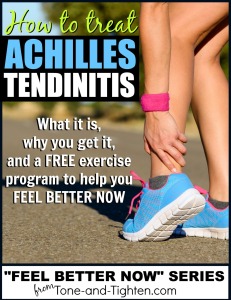 What is it? Your Achilles tendon is the fibrous tendon that connects the bottom of your calf to the back of your foot. When our calf muscles contract, it pulls through our tendon to point our toes down towards the ground. We put stress on this tendon while running, jumping, walking, and pretty much doing anything active. It’s pretty much vital to normal human movement and (most of the time) does it’s job flawlessly. But what happens when it starts acting up?
What is it? Your Achilles tendon is the fibrous tendon that connects the bottom of your calf to the back of your foot. When our calf muscles contract, it pulls through our tendon to point our toes down towards the ground. We put stress on this tendon while running, jumping, walking, and pretty much doing anything active. It’s pretty much vital to normal human movement and (most of the time) does it’s job flawlessly. But what happens when it starts acting up?
Why do you get it? In most cases, Achilles tendinitis develops as an overuse injury. Too much of an activity without adequate rest, recovery, or strength training can all be causes of Achilles tendinitis. The two most common cases that I see are 1) runners who are training for an upcoming race or 2) sedentary individuals trying to become more active. In both cases the most common mode of injury is some type of dramatic increase in activity. Now granted I do see the occasional traumatic injury – “I pulled it playing basketball” – but in my experience these are the exceptions. If you’ve got pain in your Achilles, most likely it’s from some sort of recent activity modification (including new shoes!).
What do we do about it? Just like the other conditions I’ve mentioned, we’re going to treat this tendon problem differently if it’ acute (less than 2 weeks old) versus chronic (greater than 2 wekes.
Acute (less than 2 weeks): If your Achilles has been giving you grief for less than two weeks, you’ve still got a pretty strong inflammatory response going on. The best treatment at this point is the good ol ‘RICE principle – rest (take 2-3 days off), ice (20 minutes on, 20 minutes off – all day long), compression (ACE wraps and ankle braces work well) and elevation (not too vital unless there’s a lot of swelling). Click here to learn more about RICE and rehabbing acute injuries. Anti-inflammatory medications like ibuprofen are also doing to help you out – I always recommend you take them according to the printed instructions on the label. Light stretching and gentle heel raises are also indicated at this point as demonstrated in the downloadable home exercise sheet below.
Chronic (more than 2 weeks): If your Achilles has been bugging you for more than two weeks, you’re starting to get into a new phase of the healing process that is going to require a little more TLC on your part than if we were still dealing primarily with inflammation. It should still respond to the RICE principle indicated above as well as all the exercises below, but you’re also going to need to add some pretty aggressive massage to the heel, also. Massage assists in the tissue remodeling phase and will help the Achilles to heal stronger. 5-10 minutes a day; everyday as long as it’s not causing significant pain (if it’s too painful the next day after you massaged it you need to skip massage for that day). Massage the Achilles just one time per day before performing one set of exercises indicated at the following link:
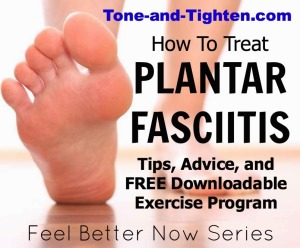 What is it? The plantar fascia is a large, broad ligament on the bottom of your foot. It starts on your heel and then fans out to each one of your toes. It’s job is to add structural integrity to your foot, support your arch, and basically keep your foot from falling apart. The plantar fascia also acts as a shock absorber as we’re walking/running and can even provide a little recoil as our foot comes off the ground to maximize energy (literally giving us a “spring in our step”). It’s really quite a remarkable structure when all things are working the way that they should. But what about when that’s not the case?
What is it? The plantar fascia is a large, broad ligament on the bottom of your foot. It starts on your heel and then fans out to each one of your toes. It’s job is to add structural integrity to your foot, support your arch, and basically keep your foot from falling apart. The plantar fascia also acts as a shock absorber as we’re walking/running and can even provide a little recoil as our foot comes off the ground to maximize energy (literally giving us a “spring in our step”). It’s really quite a remarkable structure when all things are working the way that they should. But what about when that’s not the case?
Why do you get it? Given all these functions the plantar fascia is usually under a fair amount of stress. Plantar fasciitis occurs when this ligament is placed under too much stress/strain (usually right at the place where the plantar fascia attaches into the heel) and initiates an inflammatory response. Now don’t get me wrong, inflammation is a good thing. Without this response our body would never recognize that it was injured and therefore never heal itself. However, inflammation can be a real pain in the foot (literally) if it develops into a chronic state (lasting >2 weeks). This is when things can really start to be a problem as no longer are we just dealing with an acute inflammatory response. All of a sudden the problem has developed into that we would call plantar fasciosis.
Anytime you hear the suffix “-osis” on the end of a word that’s indicative of degeneration. Now don’t get too worried about this- it’s not wasting away to nothing. It simply means that you’ve had the problem a little bit longer and your plantar fascia has started to develop some scar tissue in response to the chronic inflammation (the body’s natural healing mechanism is scar tissue; also a good thing at the right time and in moderation). This distinction becomes very important when we start talking about the treatment of your plantar fascia pain. One would treat a plantar fasciitis very differently than one would treat a plantar fasciosis.
What do we do about it?
Acute plantar fasciitis (less than two weeks): If you’ve been experiencing foot/heel pain for less than two weeks that probably means you’ve got an acute inflammatory response in your plantar fascia. That being said, it should respond well to anti-inflammatory measures. I recommend an oral anti-inflammatory (consult your physician to determine which one is most appropriate for you; my personal go-to is ibuprofen), rest as much as possible, and ice applied to the area 3-4 times per day (15-20 minutes at a time). You should also be doing some gentle, regular stretching 3-4 times a day as outlined in exercises in the program in the link below.
Chronic plantar fasciosis (grater than two weeks): is a little (okay A LOT) more difficult to treat. Again because of the chronic inflammatory state of the ligament there is usually some scar tissue that has developed. All of the sudden we’re not simply dealing with chasing away inflammation so much as trying to treat a structural change in the tissue itself.
Deep massage to the area where the plantar fascia inserts into the heel is a great way to encourage blood flow and healing in an area. Rolling a golf ball on the bottom of your foot is an excellent way to self-massage your foot. My go-to (another gem from Jared!) is a frozen water bottle. Keep a bottled water in the freezer and roll your foot on that for 10 minutes a day to get a great ice massage on the bottom of your foot. At first massage will probably be a little bit tender, but you should notice your tolerance improves with time and with that comes improved activity with decreasing foot pain.
Comfortable stretching is a must in the treatment of plantar fasciosis. I emphasize comfortable here because stretching too aggressively can actually cause more harm than good. Stretching must be very comfortable but then you do it multiple times during the day. There are some good stretches for the plantar fascia, but you mustn’t forget the calf/Achilles as well – a number of the fibers of the plantar fascia are actually continuous with the Achilles tendon fibers. Thus a thorough stretching of the plantar fascia will also include a good stretch to the calf as well.
Finally strengthening/stabilization of the foot to better support the plantar fascia is a must. We do this by strengthening the intrinsic foot muscles as well as the calf. Eccentrics or “negatives” are proven to heal tendon/fascia problems a little more effectively than regular exercise.
Running is a great sport with thrilling rewards. You can do it successfully! You don’t have to run with pain! Try some of the tips, tricks, and exercises presented in this article to enjoy a long and injury-free running season!
Did you find this post useful? Share it on social media! See my social sharing boxes down below to easily share on your Facebook wall, pin it to your Pinterest board, or Tweet out this great information! Your fellow runners will thank you!
Make it happen,
Jared
By Jared Beckstrand
Disclaimer: The information presented in this post is designed to be used for informational purposes only. The diagnoses and treatment plans outlined are extremely generalized and may or may not be the recommended interventions for your specific problem. If you are experiencing pain, you are encouraged to consult a healthcare provider to determine the best treatment plan that will be in your best interest individual. Tone and Tighten claims exemption from accident, injury, or perpetuation of any injury incurred while performing exercises found on this website. The user assumes all risk … and reward !!
